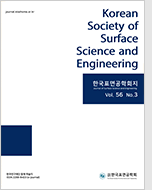
- Past Issues
- e-Submission
-

2021 Impact Factor 1.766
5-Year Impact Factor 1.674
Editorial Office
- +82-2-563-0935
- +82-2-558-2230
- submission@kssse.or.kr
- https://www.kssse.or.kr/

2021 Impact Factor 1.766
5-Year Impact Factor 1.674
The Korean Society of Surface Science and Engineering 2023;56(4):243-249. Published online: Aug, 30, 2023
DOI : https://doi.org/10.5695/JSSE.2023.56.4.243
Urea oxidation reaction (UOR) via electrochemical oxidation process can replace oxygen evolution reaction (OER) for green hydrogen production since UOR has lower thermodynamic potential (0.37 VRHE) than that of OER (1.23 VRHE). However, in the case of UOR, 6 electrons are required for the entire UOR. For this reason, the reaction rate is slower than OER, which requires 4 electrons. In addition, it is an important challenge to develop catalysts in which both oxidation reactions (UOR and OER) are active since the active sites of OER and UOR are opposite to each other. We prove that among the NiFe2O4 nanoparticles synthesized by the hydrothermal method at various synthesis temperatures, NiFe2O4 nanoparticle with properly controlled particle size and crystallinity can actively operate OER and UOR at the same time.
Keywords Nanoparticle; Hydrothermal method; Oxygen evolution reaction; Urea oxidation; Hydrogen production.